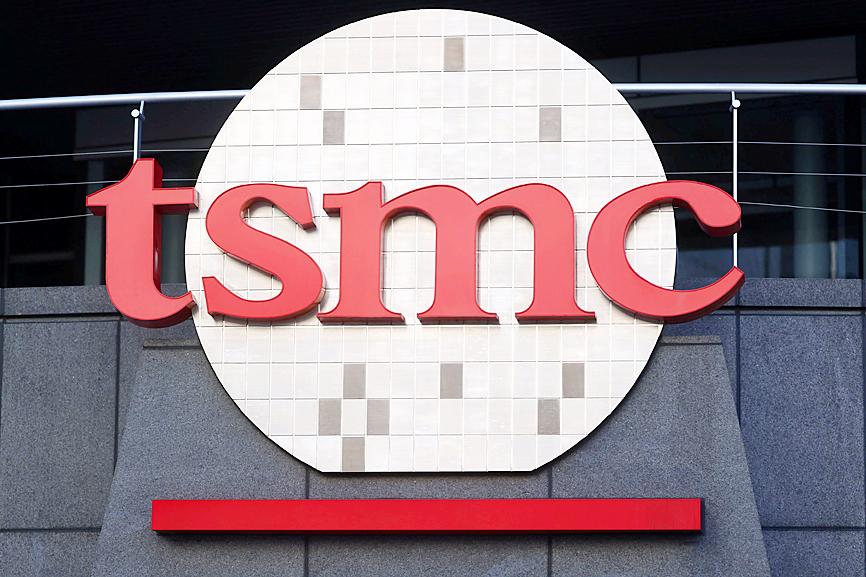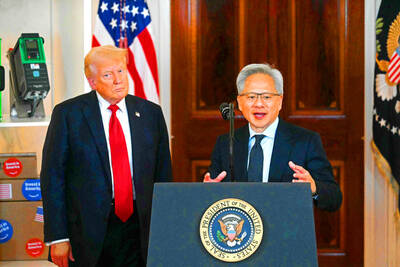Taiwan Semiconductor Manufacturing Co (TSMC, 台積電) shares tumbled 3.03 percent yesterday as investors worried about an Intel Corp plan to return to the foundry business.
The stock closed at NT$571 in Taipei trading, with turnover surging to 115.32 million shares, the most in about a month, after Intel chief executive officer Pat Gelsinger announced it would invest US$20 billion to build two new fabs in Arizona, as well as develop a new standalone foundry business to make chips for other companies.
At the same time, Intel would bolster its partnerships with third-party foundries to farm out more production, Intel said in a statement.

Photo: Ann Wang, Reuters
The move might create an awkward competitive-collaboration environment between the company and foundries.
The Santa Clara, California-based chipmaker is to offer intellectual property (IP) portfolios for customers, including for its own x86 cores, as well as Arm Ltd and RISC-V ecosystem IP, it said.
The announcement is a clear indication that “Intel is determined to come back to foundry business,” Cornucopia Capital Partner Ltd (聚芯資本) managing partner Eric Chen (陳慧明) said by telephone.
“This is certainly bad news for TSMC, but how bad it is depends on how Intel allocates its capacity and resources to fulfill its goal of becoming a world-class foundry,” Chen said.
All in all, it will require more than determination for Intel to become a real challenger to TSMC, the world’s biggest foundry service provider, he said.
“There is a long way to go,” Chen said, adding that TSMC has become a big foundry with significant capacity and IP investment.
“I doubt Apple Inc, Nvidia Corp or Advanced Micro Devices Inc will turn to Intel for chip supply, given unresolved lawsuits and direct competition,” he said.
Intel has lagged behind TSMC in advancing chip manufacturing technologies.
The US chipmaker yesterday said it is to enter the final design stage of 7-nanometer chips this year, while TSMC plans to start mass production of 3-nanometer chips next year.
“Intel is doing the right thing,” Chen said.
Its plan would allow the company to secure substantial subsides and resources from the US government, as Washington is pushing for products to be made in the US and reduce its dependence on TSMC for chip supply, he said.
In addition, Intel’s heavy investment in new fabs would attract suppliers of semiconductor components and materials to Arizona, making the state a major semiconductor manufacturing hub, like science parks in Taiwan, he said.
TSMC in 2023 plans to complete a new US$12 billion fab in Arizona to make 5-nanometer chips.

Taiwan Semiconductor Manufacturing Co (TSMC, 台積電) last week recorded an increase in the number of shareholders to the highest in almost eight months, despite its share price falling 3.38 percent from the previous week, Taiwan Stock Exchange data released on Saturday showed. As of Friday, TSMC had 1.88 million shareholders, the most since the week of April 25 and an increase of 31,870 from the previous week, the data showed. The number of shareholders jumped despite a drop of NT$50 (US$1.59), or 3.38 percent, in TSMC’s share price from a week earlier to NT$1,430, as investors took profits from their earlier gains

AI TALENT: No financial details were released about the deal, in which top Groq executives, including its CEO, would join Nvidia to help advance the technology Nvidia Corp has agreed to a licensing deal with artificial intelligence (AI) start-up Groq, furthering its investments in companies connected to the AI boom and gaining the right to add a new type of technology to its products. The world’s largest publicly traded company has paid for the right to use Groq’s technology and is to integrate its chip design into future products. Some of the start-up’s executives are leaving to join Nvidia to help with that effort, the companies said. Groq would continue as an independent company with a new chief executive, it said on Wednesday in a post on its Web

CHINA RIVAL: The chips are positioned to compete with Nvidia’s Hopper and Blackwell products and would enable clusters connecting more than 100,000 chips Moore Threads Technology Co (摩爾線程) introduced a new generation of chips aimed at reducing artificial intelligence (AI) developers’ dependence on Nvidia Corp’s hardware, just weeks after pulling off one of the most successful Chinese initial public offerings (IPOs) in years. “These products will significantly enhance world-class computing speed and capabilities that all developers aspire to,” Moore Threads CEO Zhang Jianzhong (張建中), a former Nvidia executive, said on Saturday at a company event in Beijing. “We hope they can meet the needs of more developers in China so that you no longer need to wait for advanced foreign products.” Chinese chipmakers are in

POLICY REVERSAL: The decision to allow sales of Nvidia’s H200 chips to China came after years of tightening controls and has drawn objections among some Republicans US House Republicans are calling for arms-sale-style congressional oversight of artificial intelligence (AI) chip exports as US President Donald Trump’s administration moves to approve licenses for Nvidia Corp to ship its H200 processor to China. US Representative Brian Mast, the Republican chairman of the US House Committee on Foreign Affairs, which oversees export controls, on Friday introduced a bill dubbed the AI Overwatch Act that would require the US Congress to be notified of AI chips sales to adversaries. Any processors equal to or higher in capabilities than Nvidia’s H20 would be subject to oversight, the draft bill says. Lawmakers would have